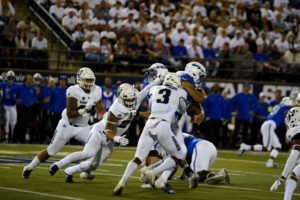Mountain battle: Air Force vs Utah State preview
Utah State head coach Gary Andersen sums up the quality of this week’s opponent pretty well in one quote: “It’s a huge challenge this week. Air Force is not a good team, but a great team in all areas: offense, defense and special teams.”
Air Force has won 10 games twice over this decade, a pretty decent bar to clear to be considered the best team over the past 10 years. But that just might be what this year’s version of the team is. Currently, the Falcons are averaging a conference-high 37.4 points per game, good for 18th in the nation.
Fresh off a 56-26 thumping of Hawaii, the offense is playing more efficiently than at any other point thus far in the young season. This can partially be explained to the expanded playbook the team has implemented at the start of the season.
“There are a number of plays in there. What appears to be the triple option, many times is not the triple option,” Andersen said. “It may be a zone play. It may be a dive play. It may be a cutoff on the away zone on the backside where they’re running the triple option phase of it, but they’re going to hand the ball off. There are a number of different ways that they attack you.”
Last season, of any opponent Utah State played at home, Air Force would be most people’s suggestion as the toughest test for the Aggies. Leading 35-17 after three quarters, Utah State allowed the Falcons to creep back into the game by giving up 15 points in the final frame. Air Force was not able to pull off a victory, but it kept itself in the contest despite not having the best day statistically. Along with the Falcons being near the top of the conference in offensive statistics, they are close to the top in a few statistics defensively as well. However, defensive efficiency and turnover margin are two spots where the Falcons struggle.
Air Force is second-to-last in defensive efficiency in the Mountain West and 80th in the nation in turnover margin. For the season, the team has forced nine turnovers, while committing 10 (seven fumbles and three interceptions) of their own. Out of just 72 throws all season, Air Force had three balls intercepted. That is actually on par with some of the other triple option teams in the nation, Navy and Army, who have both attempted less than 75 passes and had three balls intercepted. But statistically, that is pretty poor. No other team that has thrown three interceptions attempted less than 147 passes and the INT/ATT ratio of 4.16 % is higher than Utah State’s — and the Aggies have nine interceptions thrown on the season. In addition, the Falcons will most likely be starting a third-string quarterback with injuries haven taken out the first two options in previous games. Although, senior quarterback Mike Schmidt was a key reason why Air Force was so dominant against Hawaii last week, albeit against a defense that has given up the second-most touchdowns in conference.

Jontrell Rocquemore, a senior OLB, tackles an Air Force player. USU beat the Falcons with a final score of 42-32.
No matter what the statistics say, playing against a triple option team comes with its own unique set of challenges. Andersen feels the team goes to all lengths to prepare to face it, even with the rarity of facing that offensive style.
“Camp, spring ball, bye weeks, the day after Christmas. Whenever we find an opportunity to squeeze in a few moments of Air Force, we’ll absolutely do it,” he said. “You have to in my opinion. That goes back to how many years I’ve played them.”
Eventually, for Utah State, the passing game has to come together. Andersen commented after the Nevada game about having to go back through the tape and evaluate what has lead to the Aggies’ downfall in that department. If Air Force has a strength on its defense, it is stopping the run. They are big, physical and disciplined. Forcing a quick three-and-out leads directly into the team’s strategy of controlling the clock and controlling the tempo of the game. Saturday night will be an ideal opportunity for the Aggies to break out of the early-season slump and get back into a rhythm through the air. However, this requires more than just junior quarterback Jordan Love to execute.
“We don’t want him to push in any way, shape or form, but his guys need to pick him up. They need to make the great plays,” he said. “You have to catch contested balls, and you have to be able to make the plays when you have layups. It’s all over on that side.”
As would be expected, many things factor into why a certain part of the team is struggling. Love may be the one pulling the strings, but football is only effective if all 11 players are on the same page. The defense can also play a part in this to some degree. Getting the ball back to the offense quickly helps them develop a rhythm and feel more confident in how they are attacking the game. For Utah State, one of the biggest challenges will be keeping Air Force from being efficient on the Aggies’ side of the field.
“Our success in the red zone is definitely a testament to the defensive line. They’re relentless,” sophomore cornerback Andre Grayson said. “They get through the cracks of the O-line play after play, and that makes it a lot easier for our safeties to step up, our linebackers to step up and fill those holes and make those stops.
“That’s what we’re going to need. We’re going to need a lot of toughness when it gets down there, because Air Force is really effective and we know that.”
Twitter: @dren_sports

